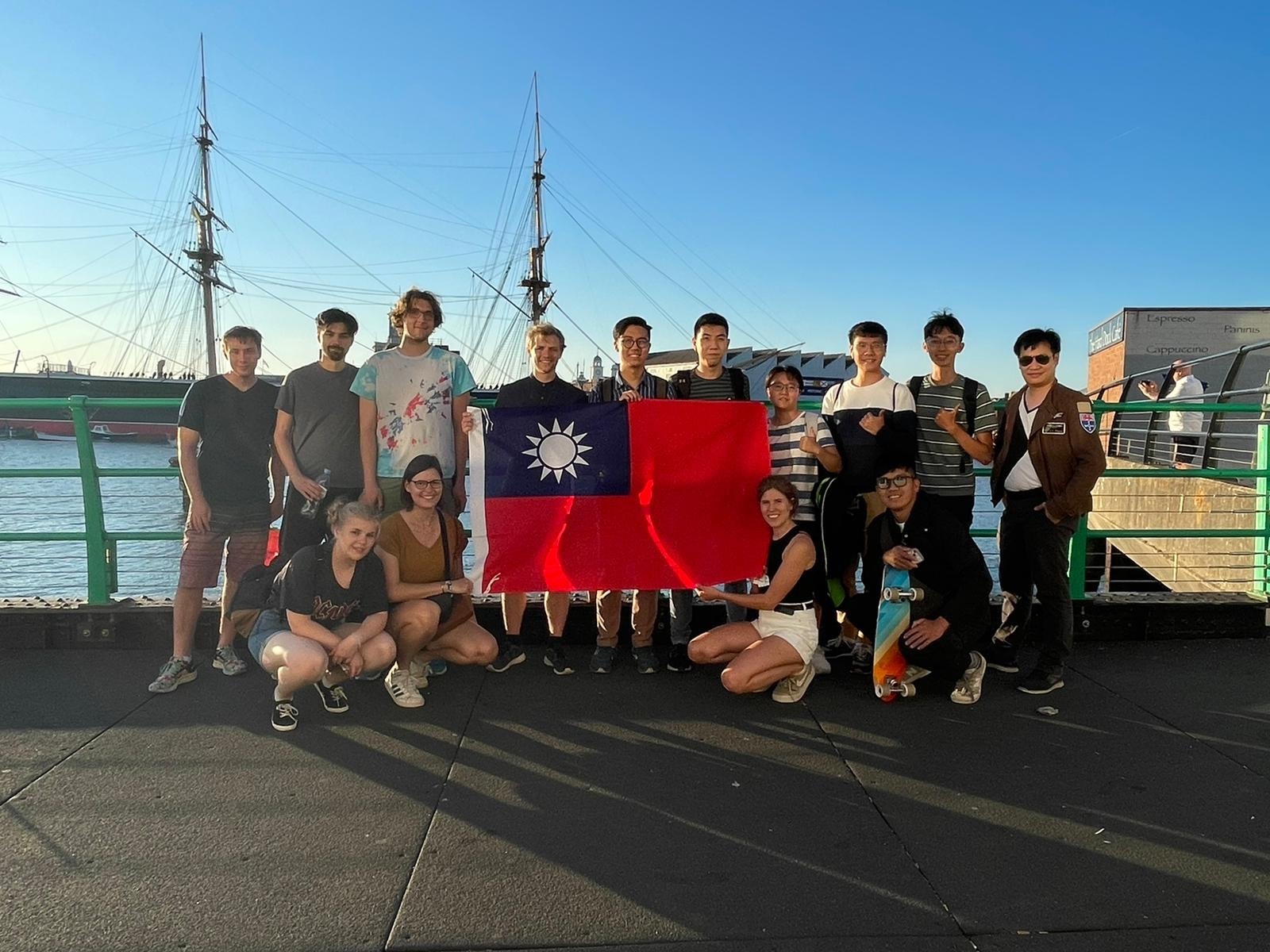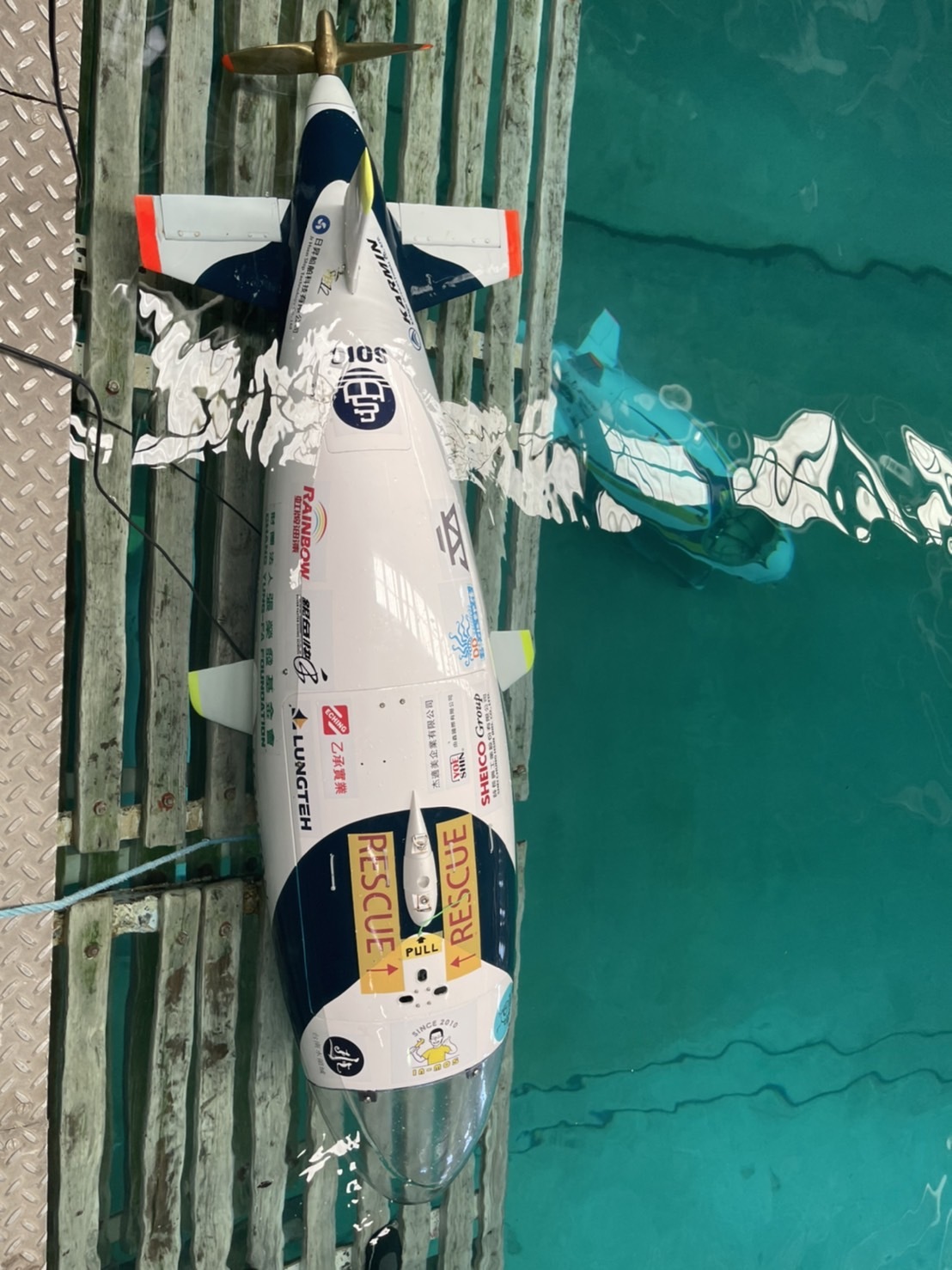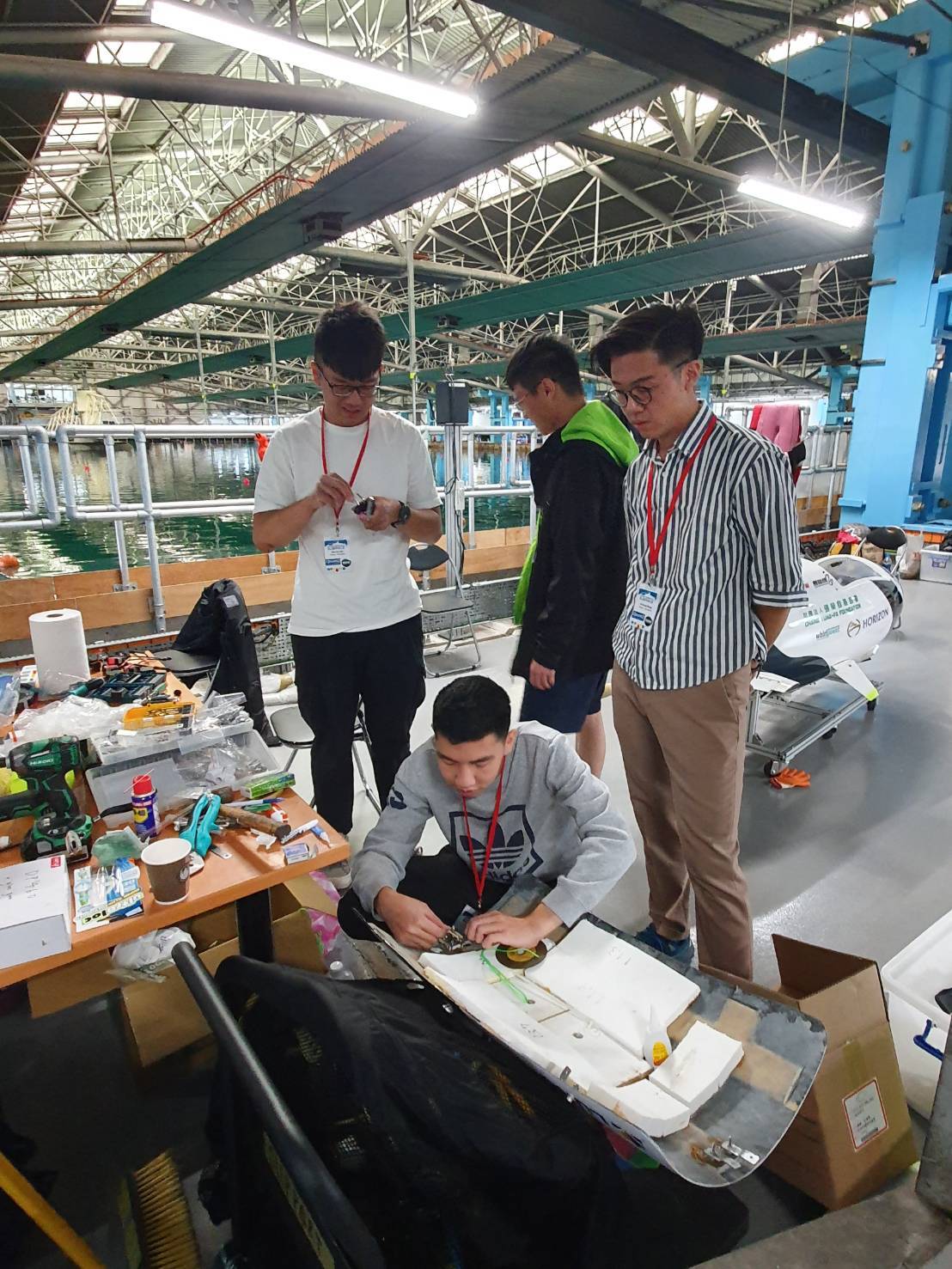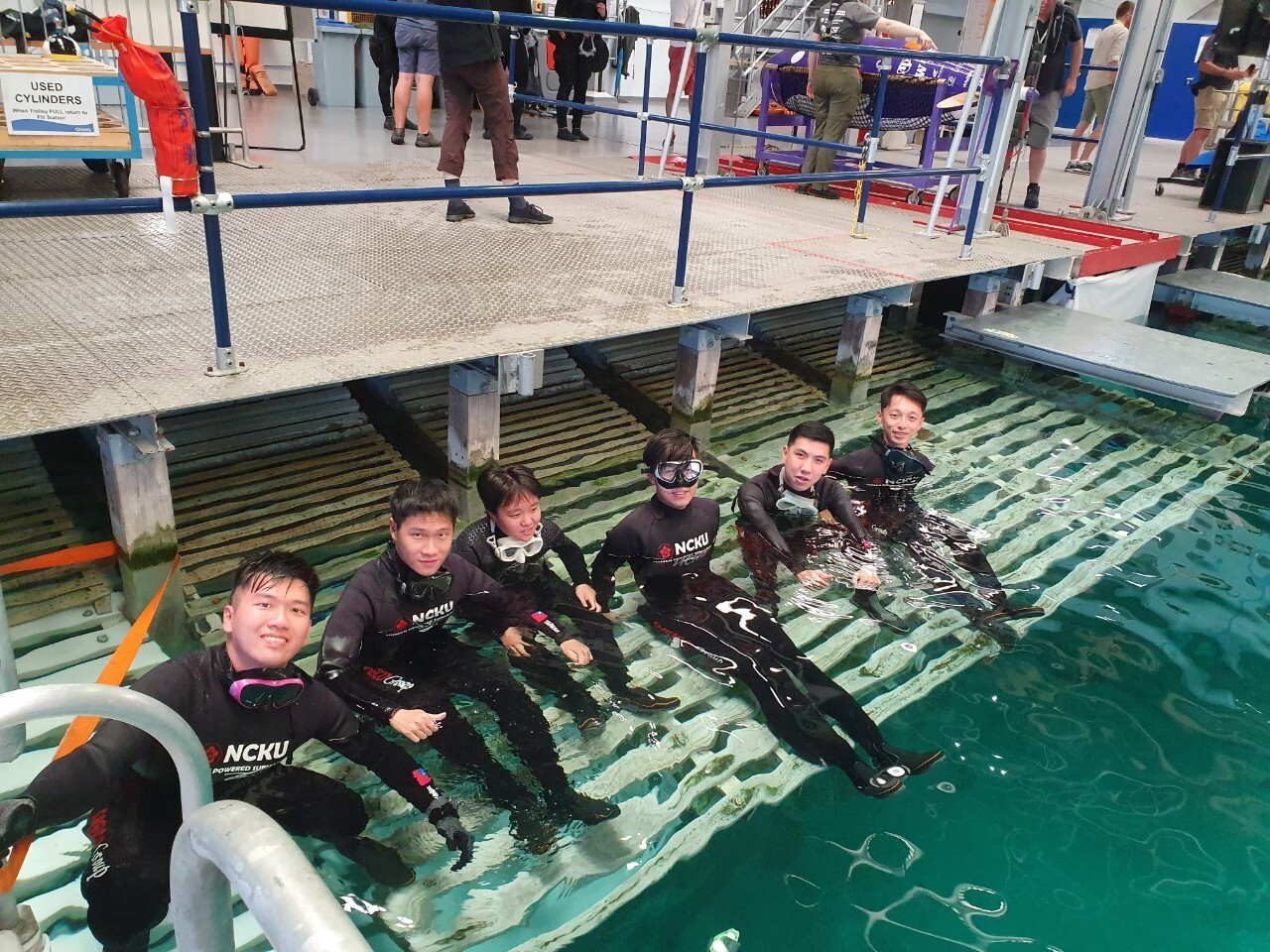NCKU Milkfish sat-ba̍k-hî Competing in Europe International Submarine Races Receives Encouragements with a Photo of National Flag
Written by Hsu Tsu-Yueh. Image credit to News Center.

TAO-HAI-REN members and students from several participating teams held the R.O.C. national flag together
Student submarine team TAO-HAI-REN, bringing along the nation’s first human-powered submarine “sat-ba̍k-hî”, arrived in Portsmouth, U.K. to take part in the Europe International Submarine Races. The team’s name TAO-HAI-REN means “fisherman” in Mandarin Chinese; the submarine’s name “sat-ba̍k-hî” means “milkfish” in Taiwanese. This student team from National Cheng Kung University is the first non-NATO and non-EU team in history to participate in this competition. While in the U.K., the students visited local cultural institutions. In one photo posted on the eISR Facebook page, TAO-HAI-REN members and students from several participating teams held the R.O.C. national flag together, giving Taiwanese students best wishes.
Instead of engaging in head-to-head competitions, the participating teams in eISR are required to pass all test trials to qualify for the final judgement. The NCKU TAO-HAI-REN team arrived in Portsmouth on July 3. After successfully passing the dry check on land, the team needs to pass the rest of the tests in order to compete in the final race on July 15. The team is participating as the first Asian team, and the team members were faced with multiple challenges, including the low water temperature in the unfamiliar tank. As soon as people in NCKU learned of this, teachers and students flooded TAO-HAI-REN’s Facebook page with good wishes and encouragements.

Student submarine team TAO-HAI-REN, bringing along the nation’s first human-powered submarine “sat-ba̍k-hî”, arrived in Portsmouth, U.K.
Through two years of endeavor, the TAO-HAI-REN team realized their dream of entering an international competition. Led by their instructing professor, the team members, fifth-year student Pi-Cheng Wang (王丕丞), senior students Hao-Cheng Hsueh (薛皓丞), Heng-Yu Wei (魏珩育), and Wei-Jen Hsu (許瑋仁), junior student Yun-Hao Han (韓允豪), and freshman Dan-Hsu Wang (王丹詡) of the university’s Department of Systems and Naval Mechatronic Engineering, work to bring out their best performance in the race. For several days they made continuous adjustments to the submarine, however, after passing the dry check, the wet test originally scheduled for July 11 was postponed to 4 p.m. on July 12 (Taiwan time zone) due to necessarily adjustments to the material because of temperature and pressure differences. The testing ground is within military control zone and the participants have to abide by strict time limit. The team must finish the adjustments before beginning test trials, and can only enter the final race after passing all tests.
Team leader Pi-Cheng Wang expressed that the order of the pre-race wet test was determined through a draw. The water temperature at the testing ground was 13°C while the team used to practice in 28°C water in Tainan. “The water doesn’t get below 19°C in Taiwan even on the coldest day. The water temperature is really low here. We keep shivering even after coming back on land!” The team members also had to overcome jet lag on top of the low water temperature. Because they are the first participating Asian team, the organizers gave a lot of attention to ensuring the members’ safety. The hatch to the cockpit of sat-ba̍k-hî was considered too narrow and the judges required adjustments be made. The team members hurriedly modified the design to the hatchway to appropriate adjustments and passed the dry check eventually.

The wet test originally scheduled for July 11 was postponed to 4 p.m. on July 12 (Taiwan time zone)
“Many unexpected problems popped up. So far, the more challenging problem remains the issue of the submarine trim.” Team member Hao-Cheng Hsueh expressed that, during the first wet check of the sat-ba̍k-hî, the team found lessened buoyancy for the submarine due to greater water pressure as the 5-meter-deep tank was is over twice the depth of the 2.3-meter-deep practice tank in NCKU. Moreover, the oxygen cylinder for the pilot weighted different from the equipment in Taiwan. The submarine had to undergo several adjustments to perform in the new environment. The organizers offered foam of the Canadian team to assist them in quickly completing the tests.
The team’s instructing professor Jeng-Horng Chen (陳政宏), associate professor at NCKU Department of Systems and Naval Mechatronic Engineering, explained that trimming of the submarine is key to its balance. The submarine is equipped with weights below and buoyancy material on top, so that it can remain balanced both across lateral and longitudinal axes. All of this has to be calculated beforehand then be adjusted according to actual performance in water. Currently the students are working to overcome the problems in order to successfully pass the wet test and then begin test runs in the course. The team aims to compete alongside the excellent teams from the U.K., Germany, Canada, and the U.S.A. in the final race on July 15.

Students are working to overcome the problems in order to successfully pass the wet test and then begin test runs in the course
The team will begin running laps in the 165-meter-long course, including straight-line acceleration, 180-degree 25-meter-radius turn, and a slalom course, according to team leader Pi-Cheng Wang. The submarine has to take different routes to match different items in each run. The teams take turns in completing each mission. “Team members work hard to overcome all types of issues in order to pass the challenge.” Doing well in the straight-line acceleration and maintaining good control in the 180-degree turn and the obstacle course are key to acing the test.
“With everyone’s encouragements, the team is optimistic about completing all test items and entering the final race,” Jeng-Horng Chen said. Since 2012, the race, held biennially, has provided international shipbuilding students a stage to realize their dreams. Student teams start from designing, manufacturing, to steering their own submarines. Eventually these submarines complete the course including straight-line acceleration, 25-meter-radius turn, and a slalom course, and the teams are evaluated by their completion time and the innovativeness of submarine designs. Some teams take less time to advance into the next stage, with completion time and performance recorded for each stage. During training on campus, sat-ba̍k-hî excels in its straight-line acceleration. The team continues to make adjustments, aiming to smoothly complete the race.

The members of TAO-HAI-REN need to overcome the low temperature and unfamiliar underwater enviroment during competition
Provider:
News Center
Date:
2022-07-30




